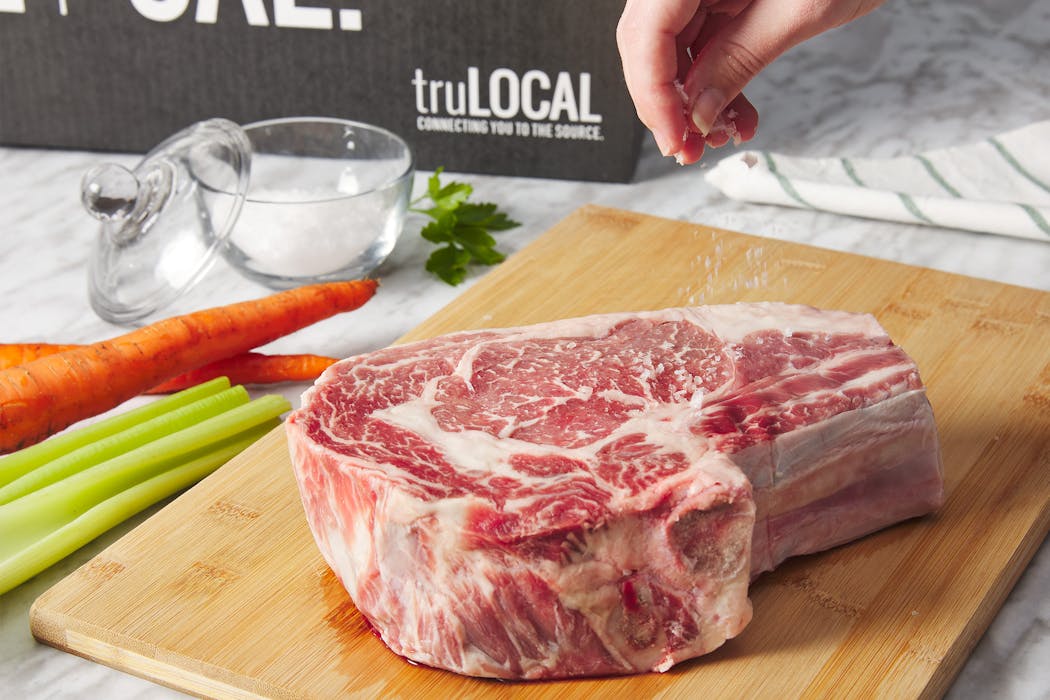Storing and Defrosting Meat
Your truLOCAL box has arrived, you’ve got a few weeks’ worth of frozen meat, and if you’re not used to shopping for frozen products, the next steps can be intimidating.
 Back
Back






Your truLOCAL box has arrived, you’ve got a few weeks’ worth of frozen meat, and if you’re not used to shopping for frozen products, the next steps can be intimidating.

Your truLOCAL box has arrived on your doorstep (and if it hasn’t, now is a great time to order one!) – but now what? You’ve got a few weeks’ worth of frozen meat, and if you’re not used to shopping for frozen products, the next steps can be intimidating.
Storage
First things first, you’ll want to place your items in your freezer. It’s best practice to place flatter items like bacon on the bottom, and more abnormally shaped packages like chicken wings on the top to prevent items from falling out as you make regular use of your freezer. Your freezer’s temperature should be set to -18˚C or lower.
truLOCAL products come to you flash frozen and vacuum sealed. What does that mean? Flash freezing is a process whereby a cut of meat is frozen instantly, maintaining the flavour and texture the cut had at the time of freezing. When a cut of raw meat is placed in a conventional freezer, it achieves a frozen state slowly over a span of several hours, allowing ice crystals to form between the muscle fibres, resulting in a loss of flavour and texture. This type of freezing can also contribute to freezer burn, which occurs when a frozen food item is over-exposed to oxygen. Vacuum sealed products can last in the freezer for up to a year without risk of freezer burn – and because they’re flash frozen, when you thaw them, they’ll taste just as wonderful as the day they were frozen.
If you’re storing meat products in the fridge for immediate consumption, it’s important to ensure your fridge temperature is at least 4˚C or lower to ensure your product stays out of the food temperature danger zone of 4˚C-60˚C. If food is left within the temperature danger zone, harmful bacteria can quickly multiply, leading to greater susceptibility to illness such as food poisoning. Beef, pork, and lamb can remain in the fridge uncooked for 2-4 days and poultry for 2-3 days. Shellfish last up to 24 hours uncooked, where lean or fatty fish (salmon, cod, etc.) can last for 3-4 days before being cooked and consumed.
Defrosting
Though there are a few exceptions to the rule, for a majority of our products, it’s best to thaw before cooking. Why? For most cuts of meat, when you cook from frozen, you risk overcooking the outside of the cut while leaving the middle within the temperature danger zone – and you may compromise the texture of the meat, resulting in a less than desirable culinary experience. Cooking evenly, and reaching a safe internal cooking temperature, is key to killing harmful bacteria in meat that may cause food poisoning. Meat that is not thawed properly, or that is not cooked to an appropriate internal temperature, could cause food-borne illness.
The safest and most recommended method of thawing is to place your product on a plate or in a bowl (depending on the size and shape of the product and its package) and place it in your fridge on the bottom shelf. This will catch any leaking juices and prevent accidental cross-contamination. Smaller cuts will take less time to thaw, where larger options like roasts may take longer – most cuts of meat will be defrosted and ready to cook within 24 hours. Refer to safe storage guidelines above to determine how long you can leave your meat in the fridge before cooking.
If you’ve forgotten to take meat out and thaw it in the fridge ahead of time, or you want to cook something the same day it arrives, you can also thaw in the sink. You can either run cold water from the tap over the meat until it’s defrosted, or you can submerge it in a sink filled with cold water. Ensure the packaging is left on the product and change the water every 30 minutes until your meat is fully thawed. Alternately, you can take your meat out of the vacuum sealed packaging and place it in a microwave-safe dish and use the defrost setting on your microwave to thaw your product.
When handling raw meat out of the package, you’ll want to avoid cross-contamination throughout your kitchen. Anywhere your product has been handled – the sink, a cutting board, a dish – will need to be sanitized thoroughly before it is used for any other purposes.
Article by: Trish Carnahan
Posted on November 5th, 2020